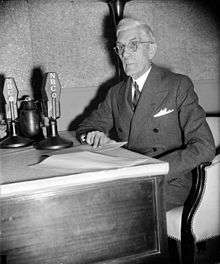Francis Townsend
Francis Everett Townsend (/ˈtaʊnzənd/; January 13, 1867 – September 1, 1960) was an American physician who was best known for his revolving old-age pension proposal during the Great Depression. Known as the "Townsend Plan", this proposal influenced the establishment of the Roosevelt administration's Social Security system. He was born just outside Fairbury, Illinois, where he is memorialized by a post office named in his honor.
Francis Townsend | |
|---|---|
 Townsend c. 1939 | |
| Born | Francis Everett Townsend January 13, 1867 |
| Died | September 1, 1960 (aged 93) |
| Nationality | American |
| Alma mater | Omaha Medical College |
| Occupation | Physician, public health officer |
| Known for | Townsend Plan |
| Spouse(s) | Wilhelmina "Minnie" Bogue |
Life and career
Francis Everett Townsend was born the second of six children on January 13, 1867, in Fairbury, Illinois.[1] After Townsend contracted swamp malaria as an infant, the Townsend family moved to Nebraska where Townsend had two years of high school education.[1] In 1898, Townsend borrowed $1,000 from his father and moved to Southern California to develop a hay farming business.[1] The business was not successful, and Townsend enrolled in Omaha Medical College when he was 31.[1] After graduating, Townsend worked in the medical field in Belle Fourche, South Dakota, and met a nurse and his future wife, Wilhelmina "Minnie" Bogue.[1] At age 50, Townsend enlisted as a doctor in the army one year before the end of World War I.[1]
After the war ended in 1918, Townsend moved to Long Beach, California, to run a dry ice factory.[1] After that business quickly failed, Townsend worked for real estate agent Robert Earl Clements in Midway City, California.[1] Clements later masterminded the Townsend Plan.[1] In 1930, at the start of the Great Depression, Townsend became a Long Beach city public health officer at age 63, but lost his job three years later.[1]
Townsend died in Los Angeles on September 1, 1960.[2]
The Townsend Plan
The Townsend Plan proposed that every person over 60 be paid $200 per month. The Old-Age Revolving Pension fund was to be supported by a 2% national sales tax.[3]
There were three requirements for beneficiaries under the Plan:
- they had to be retired;
- they had to be "free from habitual criminality;"
- they had to spend the money within 30 days (to stimulate the economy.)[3]
Promoting the plan

In September 1933, Townsend wrote a letter to the editor of the local newspaper (the Long Beach Press-Telegram)[4], and launched his career as an old-age activist.[1] According to Townsend's autobiographical memoir, New Horizons (1943), his plan originated when he looked out his window one morning in the early depth of the Depression and saw two old women, dressed in once nice, now tattered clothes, picking through his garbage cans looking for food. Within two years of his putting forward his plan, over 3400 Townsend Plan Clubs were organized all over America and began exerting pressure on Congress to pass an old-age pension. Frances Perkins, President Roosevelt's Secretary of Labor, in her memoir, The Roosevelt I Knew (p. 294) says that Roosevelt told her, "We have to have it [Social Security]. Congress can't stand the pressure of the Townsend Plan unless we have a real old-age insurance system." As Roosevelt said, Social Security was passed by Congress substituting a pay-as-you-go "insurance" scheme for Townsend's far more generous pension plan, but as he told Perkins, it was the Townsend Clubs that forced Congress to act at all.
After the adoption of Social Security and Townsend's death
The movement continued after the Roosevelt administration adopted Social Security in 1935 and beyond Townsend's death in 1960.[5] In 1978, The Associated Press reported that the National Townsend Plan would be shut down by the end of February that year, with only state chapters surviving, and that by then it had a "dwindling and aging membership."[5]
References
- Amenta, Edwin (2006). When Movements Matter: The Townsend Plan and the Rise of Social Security. Princeton University Press. pp. 36–38. ISBN 0691124736. Retrieved May 26, 2012.
- "Dr. Francis Townsend, 93, Dies; Founded Old-Age Pension Plan". The New York Times. New York. The Associated Press. September 2, 1960. Retrieved January 19, 2019.
- Larry Dewitt (December 2001). "Research Note #17: The Townsend Plan's Pension Scheme". Research Notes & Special Studies by the Historian's Office, Social Security Administration. Retrieved October 26, 2014.
- David Dayen (October 29, 2013). "How a Frustrated Blogger Made Expanding Social Security a Respectable Idea". Pacific Standard. Retrieved January 13, 2014.
- "Townsend Plan, Once the Hope Of Thousands, Is Near Death". The New York Times. New York. The Associated Press. February 23, 1978. Retrieved January 19, 2019.
External links
| Wikimedia Commons has media related to Francis Townsend. |
- US Social Security Administration, "The Townsend Plan Movement," Social Security History.